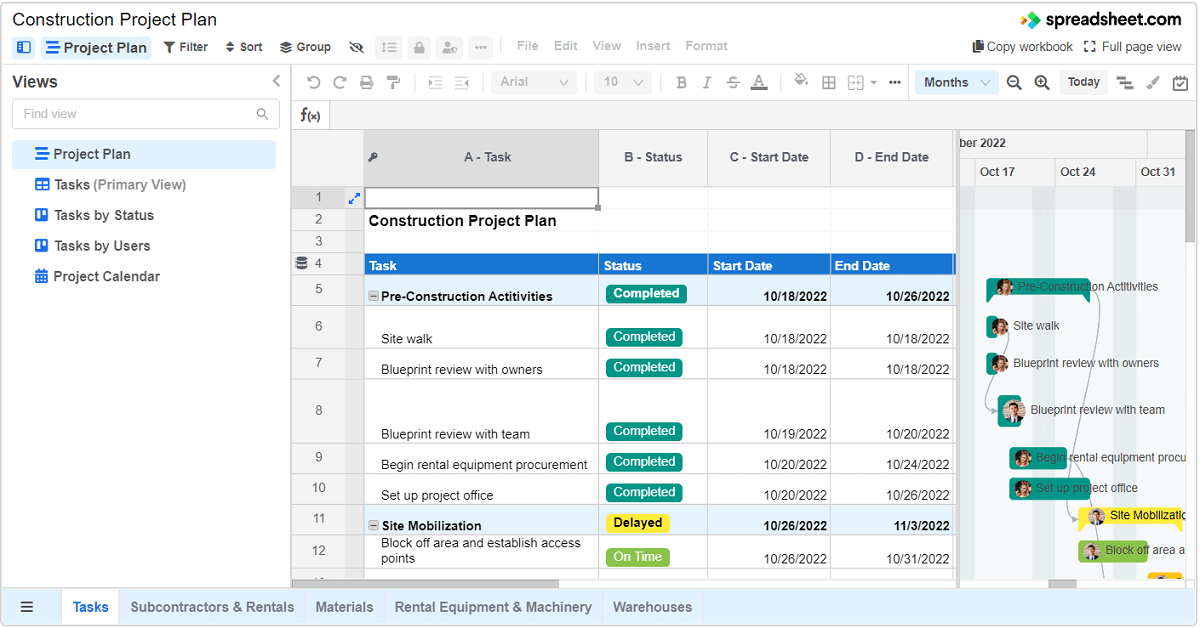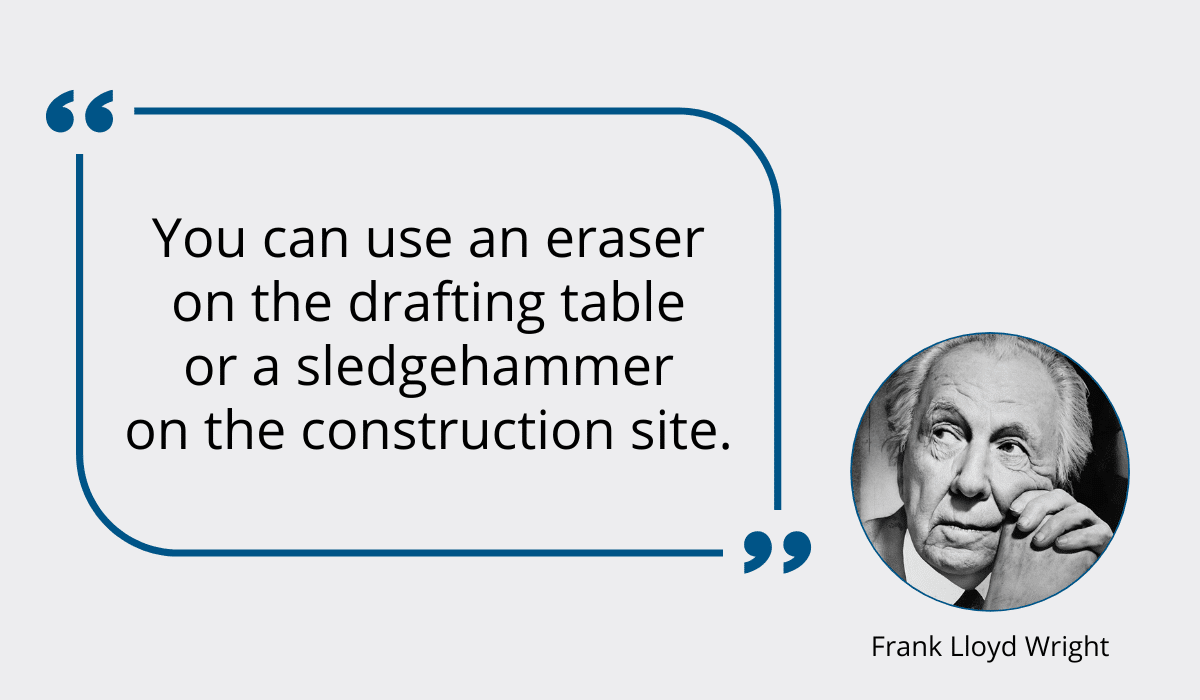A good plan is as vital for a construction project as a good script is for a movie.
It’s a complex process that includes many moving parts, but if done correctly, it will help you deliver a quality project to a client on time and within budget.
You will be able to minimize errors and make the project as efficient as possible.
Below we explain the 5 essential steps to assist you in your construction project planning.
In this article...
Start by Defining Project Goals
Goals are a vital element of every plan. Goals make your team concentrate their efforts on what matters. They act as beacons, guiding the team and ensuring no one steers off course.
Goals also increase efficiency. A study has shown that 90% of people perform better when presented with specific, challenging, but achievable goals.

Interestingly, the same study has shown that challenging goals lead to better results than easy goals.
But what constitutes a goal?
Goals are the desired outcomes of your project. They are long-term, broad, not specific, and, as such, difficult to measure.
Even though goals are necessary, defining them in a construction project can be challenging because of the many parties involved.
You have to listen to your client’s needs and translate them into goals that your contractors can deliver.
As coordination is crucial for this step, you should include as many people as possible from all levels of your and other organizations concerned, from contractors to executives.
This will eliminate misunderstandings so that everyone is on the same page.
As the project moves forward, it’s not unusual for goals to change because circumstances change all the time.
This shouldn’t be a problem if you share progress reports and notify everyone of the changes because you never know whose work can be indirectly affected by them.
A key thing to remember when setting goals is to build them from the bottom up, as argued by Les McKeown in his article How to Reach Every Business Goal—Even if the Economy Is in the Gutter.
In practice, this means that you should trust your people in the field and their expertise rather than senior management, which is primarily involved in financial matters.
The input of people directly involved in the process is invaluable for making informed decisions to ensure the project runs smoothly.
Identify the Project Scope
Now that you have your goals, it’s time to put them into context and determine the scope of the project.
Building on goals, the scope describes what needs to be done by providing additional information and factors required for a project to succeed.
Below is an example of a project scope description for a pumping system.

The project scope is an outline of the project that provides all the necessary information on tasks, timelines, deliverables, and limitations to all stakeholders.
It’s a handbook for the project, describing each task and providing necessary technical details.
Feasibility studies or site surveys would be included in this phase, as well as legal advice.
If we take pouring concrete as an example, the project scope will include details on the location, identify the digger that will be used, and list the amount of concrete to be poured.
Now that you have more specific information, your team can estimate how long it will take to complete each task and how long other stages will take.
As construction developers know better than anyone, no schedule is set in stone and will probably be modified along the way.
Still, having a rough schedule will come in handy as a point of reference throughout the project to see if the project is making adequate progress.
Similarly, you now also have enough data to make an indicative budget.
You’ve presumably hired contractors with experience who know how much something will cost, so they are a valuable source of budgeting information.
It might seem counterintuitive to make estimates of deadlines and budgets that will change anyway.
However, if you think about it, it’s easier to tweak existing plans than to create entirely new plans afterward.
Planning the Process
The next step is the actual planning.
The plan is a roadmap for turning your client’s vision into reality by providing directions and setting standards.
If the scope is about what needs to be done, a plan is about how and who will do it.
Pre-construction planning is vital if you consider that most organizations have a failure rate of 70% (projects are considered a failure if they aren’t completed on time or within budget).

To minimize the chances of this happening.
Like any other plan, a construction project plan will make the process easier by breaking a considerable amount of work into small, doable chunks.
Each task in a plan will have details, such as definition, dates, responsibilities of each team member and their relationship to others, task priority and the correct sequence of how to do them, tools and resources, and other relevant information.
Staying on top of it all doesn’t have to be complicated if you employ suitable systems to help you.
For example, you can use a tool and equipment tracking software such as GoCodes Asset Tracking to easily track the location of all your tools and manage your inventory using nothing but your smartphone or laptop.

Having all the necessary information available will help with time allocation.
Everyone involved will perform tasks more efficiently as they know what is expected of them and when they are expected to do it.
Below is an example of what a construction project plan can look like.

As you can see, it includes tasks, their status, start and end dates, data on subcontractors and materials, and plenty of other valuable pieces of information.
This is also a part where project phases are defined. A phase is a bigger section of a project that helps structure a project.
They typically include planning/design, pre-construction, procurement, construction, and post-construction phases.
Each phase includes several tasks and usually ends with a milestone completed on a specific date.
Milestones are helpful because they allow you to track progress.
A good idea is to meet with the stakeholders after each is reached, to discuss progress and inform them of changes that took place in the meantime.
Apart from changes, a plan should also factor in risks as they are an integral part of a construction project.
Knowing how to manage them will allow you to anticipate issues and nip them before they become serious problems.
The obvious risks are related to onsite safety and finances, but there are also other things to consider, such as the quality of materials used, contractor reliability, weather conditions, or environmental risks.
A knowledgeable risk manager will be an invaluable asset to help you mitigate these and any other risks that may arise.
Design Phase
Even though some people might think this is a simple phase in which the architect merely presents their drawings, this design phase is much more than just aesthetics.
It’s a collaborative effort in which the architect’s ideas need to be reconciled with structural and engineering drawings while fitting into the budget and schedule and complying with federal, state, and local laws.
A diplomatic approach is necessary to ensure that no one takes the necessary compromises and concessions personally because this is a normal and expected part of the design process.
As the famous architect Frank Lloyd Wright once said, it’s easier to change designs than tear down walls.

Changing things later is not only inconvenient but also more expensive, so it’s crucial to try to identify and address as many risks as possible in this phase, as well as examine whether the choices are usable, functional, and safe.
Other things that will be included in this phase include:
- Site plan
- Floor plan
- Spatial planning diagrams
- Building elevations
- Preliminary cost estimate
- Interior and exterior finishes
- Color, material choices
A helpful checklist of activities by The American Institute of Architects (AIA) to manage quality in this step can be found here.
As many different actors and tasks are involved, using construction project management software will make your life much easier.
That way, you can store data and have all documents in one place and monitor costs, it helps with scheduling and meeting deadlines and provides a clear communication channel between all the parties involved.
According to Construction Coverage, the best options are the following:

Some other options include Archdesk, Visual Planning, EZOfficeInventory, or COINS. Find out more here.
Finalizing the Plan
The final step is reviewing the documentation and submitting it to the building authority in charge of plan reviews and permits at the city or county level.
Depending on the state you’re building in, you might need zoning, site, building plan, wastewater, floodplain, or another review.
Prices, duration, and processing times vary from state to state, so check this directly with your competent authority.
Here’s an example of how long obtaining a permit might take in San Luis Obispo, CA.

The size of the city and how busy the season is are some factors that might affect permit processing times.
Upon review, the reviewer can send you comments requiring you to make changes to your plans.
In the meantime, if you don’t already have one, now is the time to find a contractor by requesting bids for your project and choosing the most competitive one.
If you have a general contractor, they will probably send the project to subcontractors.
As this part will include a lot of communication between various parties, some issues you hadn’t considered before may be raised.
After you’ve resolved them, you can negotiate contract terms, and once that’s been agreed upon, sign the contract.
All that’s left is to receive your permit and begin construction.
Conclusion
Construction project planning is a challenging task because it involves many steps that must be carefully crafted and includes actors with different levels of expertise, all working towards the same goal.
However, don’t let the complexity of the process discourage you.
With suitable methodology, clearly defined expectations, sound risk management, and continued communication throughout the process, you’ll be able to use resources and labor efficiently and deliver a high-quality project.
After all, the more effort you put into planning, the more time and money you’ll save later.





